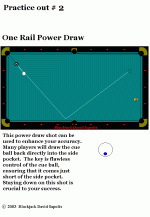Low and level draw vs elevation
Blackjack said:
I post this to simplify what is diagrammed, not to join the bickering or to participate in the childishness that has been displayed thus far in this thread.
It is very hard when people I respect are being so for lack of better words, black and white, on an issue. It is my nature to see shades of gray. I do have a couple of questions on this though and hope they can get answered in an adult manner.
A certain instructor taught me the low and level draw which required striking very low with a nice follow through. The nice thing about this technique was when practiced, a person could control exactly how far the cb draws back: an excellent tool for position.
My problem: I am used to looking at the ob last, that is what is now comfortable to my eyes. When I do this on this technique, then the cue seems to come up a little with makes it either a stop or less of a draw. i have not noticed this happening on my other shots. So, to do this correctly, i was having to keep my eyes on the cb on the follow to make sure this did not happen. I did not have the problem of scooping as some have suggested. When looking at the cb, it gets struck exactly where I am aiming it, therefore, no scoop.
I have not practiced the karate chop down on the ball from a slightly elevated position as much, although i can draw with that method. I guess i wonder if a regular pool player can get this same accuracy with this method, or does it take someone with a super fine touch. Anybody here that uses both?
I have always felt it good to be able to use both, but the low and level is really hard for me for some reason,although I will keep practicing that too.
Laura
PS I have a 'why not both' philisophy on most things, as well as this
